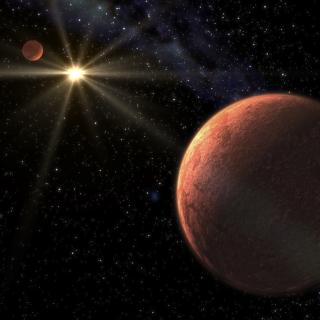Suárez Mascareño, A.; González-Álvarez, E.; Zapatero Osorio, M. R.; Lillo-Box, J.; Faria, J. P.; Passegger, V. M.; González Hernández, J. I.; Figueira, P.; Sozzetti, A.; Rebolo, R.; Pepe, F.; Santos, N. C.; Cristiani, S.; Lovis, C.; Silva, A. M.; Ribas, I.; Amado, P. J.; Caballero, J. A.; Quirrenbach, A.; Reiners, A.; Zechmeister, M.; Adibekyan, V.; Alibert, Y.; Béjar, V. J. S.; Benatti, S.; D'Odorico, V.; Damasso, M.; Delisle, J. -B.; Di Marcantonio, P.; Dreizler, S.; Ehrenreich, D.; Hatzes, A. P.; Hara, N. C.; Henning, Th.; Kaminski, A.; López-González, M. J.; Martins, C. J. A. P.; Micela, G.; Montes, D.; Pallé, E.; Pedraz, S.; Rodríguez, E.; Rodríguez-López, C.; Tal-Or, L.; Sousa, S.; Udry, S.
Bibliographical reference
Astronomy and Astrophysics
Advertised on:
2
2023
Journal
Citations
50
Refereed citations
46
Description
We report the discovery and characterisation of two Earth-mass planets orbiting in the habitable zone of the nearby M-dwarf GJ 1002 based on the analysis of the radial-velocity (RV) time series from the ESPRESSO and CARMENES spectrographs. The host star is the quiet M5.5 V star GJ 1002 (relatively faint in the optical, V ~ 13.8 mag, but brighter in the infrared, J ~ 8.3 mag), located at 4.84 pc from the Sun. We analyse 139 spectroscopic observations taken between 2017 and 2021. We performed a joint analysis of the time series of the RV and full-width half maximum (FWHM) of the cross-correlation function (CCF) to model the planetary and stellar signals present in the data, applying Gaussian process regression to deal with the stellar activity. We detect the signal of two planets orbiting GJ 1002. GJ 1002 b is a planet with a minimum mass mp sin i of 1.08 ± 0.13 M⊕ with an orbital period of 10.3465 ± 0.0027 days at a distance of 0.0457 ± 0.0013 au from its parent star, receiving an estimated stellar flux of 0.67 F⊕. GJ 1002 c is a planet with a minimum mass mp sin i of 1.36 ± 0.17 M⊕ with an orbital period of 20.202 ± 0.013 days at a distance of 0.0738 ± 0.0021 au from its parent star, receiving an estimated stellar flux of 0.257 F⊕. We also detect the rotation signature of the star, with a period of 126 ± 15 days. We find that there is a correlation between the temperature of certain optical elements in the spectrographs and changes in the instrumental profile that can affect the scientific data, showing a seasonal behaviour that creates spurious signals at periods longer than ~200 days. GJ 1002 is one of the few known nearby systems with planets that could potentially host habitable environments. The closeness of the host star to the Sun makes the angular sizes of the orbits of both planets (~9.7 mas and ~15.7 mas, respectively) large enough for their atmosphere to be studied via high-contrast high-resolution spectroscopy with instruments such as the future spectrograph ANDES for the ELT or the LIFE mission.
ARRAY(0x1f2ada0)
Related projects

Very Low Mass Stars, Brown Dwarfs and Planets
Our goal is to study the processes that lead to the formation of low mass stars, brown dwarfs and planets and to characterize the physical properties of these objects in various evolutionary stages. Low mass stars and brown dwarfs are likely the most numerous type of objects in our Galaxy but due to their low intrinsic luminosity they are not so
Rafael
Rebolo López

Exoplanets and Astrobiology
The search for life in the universe has been driven by recent discoveries of planets around other stars (known as exoplanets), becoming one of the most active fields in modern astrophysics. The growing number of new exoplanets discovered in recent years and the recent advance on the study of their atmospheres are not only providing new valuable
Enric
Pallé Bago